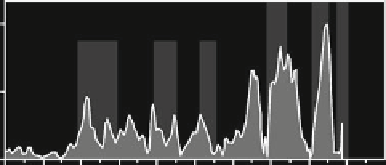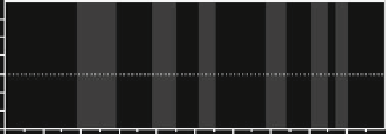Geoscience Reference
In-Depth Information
9.3.2
Size of Tsunami
Chinese + Japanese +
European meteor
sightings
each 20 years
800
700
As a rough approximation, the height of a tsunami gener-
ated by an asteroid impact with the ocean can be determined
by relating its kinetic energy to that of known tsunami
generated by earthquakes and volcanoes. For example, the
Chilean earthquake of 1960 generated a tsunami with
kinetic energy equivalent to 2-5 megatons of TNT (Toon
et al.
1997
), while the Alaskan earthquake of 1964 gener-
ated a tsunami equivalent to 0.14 megatons of TNT. The
eruption of Krakatau in 1883 was equivalent to
200 megatons of TNT. While not all of this latter energy
went into the tsunami, run-up of over 40 m occurred within
a 100 km radius. The air blast of the Tunguska bolide at the
ocean's surface produced only 0.1-0.2 megatons of energy.
This would only have generated a localized tsunami of
around 0.2 m in height had it occurred over the ocean.
However, had the comet reached the ocean's surface, it
would have created a tsunami with an initial wave height of
over 900 m. Thus most asteroids must be large or dense
enough to crash into the ocean without fragmenting in order
to produce a significant tsunami.
Of the asteroids or comets that reach the Earth's surface,
about 70 % will strike the ocean. At velocities of over
20 km s
-1
, these objects burst upon contact with the ocean,
sending out splash that can reach the top of the atmosphere
(Huggett
1989
). Collapse of water back into the cavity left
by the impact creates a tsunami wave train. The height of
the tsunami wave depends upon the displacement of water
from the pseudo-crater blasted into the ocean. The displaced
water piles up around the crater and forms a ring whose
width equals the radius of the crater (Goodman
1997
). The
tsunami's wave height can be approximated initially by the
following formula:
600
500
400
300
per century
200
100
0
0
200
400
600
800
1000 1200 1400
1600 1800 2000
Comets
15
10
5
0
-5
-10
-15
0
200
400
600
800
1000 1200 1400
1600 1800 2000
16
Fires of Tamaatea
New Zealand
12
Forest wood
Peat and bog
evidence
8
4
0
0
200
400
600
800
1000 1200 1400
1600 1800 2000
Mega-tsunami chronology
SE Australia
1.0
0.5
0.0
0
200
400
600
800
1000 1200 1400
1600 1800 2000
Year
Fig. 9.3
Incidence of comets and meteorites, and related phenomena,
between AD 0 and AD 1800. The meteorite records for China and Japan
are based upon Hasegawa (
1992
), while meteorite records for Europe
come from Rasmussen (
1991
). Peak occurrences are shaded. The Asian
comet record is based upon Hasegawa (
1992
). The calibrated radio-
carbon dates under the 'Mystic Fires of Tamaatea' are from Mooley
et al. (
1963
) for forest wood and from McGlone and Wilmshurst (
1999
)
for peats and bogs. The chronology of mega-tsunami is based upon 29
radiocarbon dates of marine shell with 5 additional AMS dates from the
Tura region of New South Wales. The dips over the last millennium are
an artifact of age reversals in radiocarbon chronology
H
m
¼
rdR
1
ð
9
:
1
Þ
t
where
H
m
= height of the tsunami wave above mean sea level (m)
r
= the radius of the pseudo-crater in the ocean (m)
R
t
= the distance from the center of impact (m)
d
= water depth (m)
As this ring moves out from the center of impact, it
causes water to oscillate up and down, forming about four
ringlets that propagate outwards as a tsunami wave train.
This process is similar to the ripples that form when a
pebble is thrown into a pond. As the wave moves away from
the impact site, its height then becomes dependent upon the
distance from the center of impact. Shoemaker (
1983
)
proposed a simple formula, based upon analogies to nuclear
explosions, to estimate the size of the crater generated by
any asteroid as follows:
played by splash (Crawford and Mader
1998
). Low-trajec-
tory asteroids can eject into the atmosphere enormous vol-
umes of water that travel at high velocities, travel hundreds
of kilometers, and fall back to the surface of the Earth over
equivalent distances (Fig.
9.4
). This splash can emulate the
erosional effects of tsunami and may be far more important
as a geomorphic process of asteroid impacts than any tsu-
nami generated by cratering in the ocean. The significance
of such events will be described later in this chapter.











